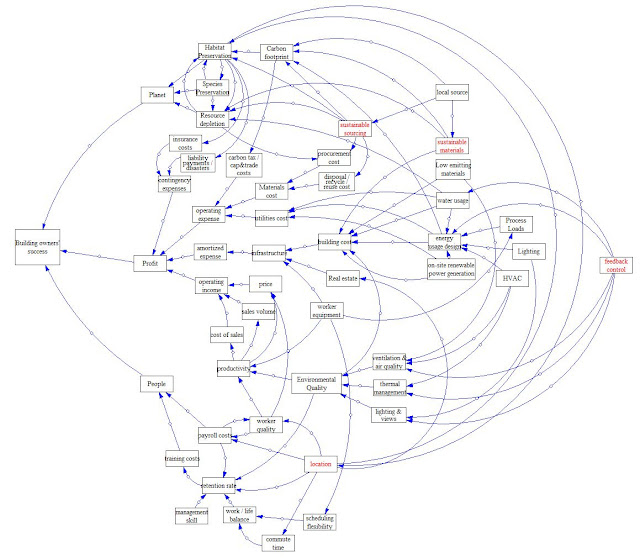This is a swag at the system, which captures, I think, some interesting connections and highlights some key leverage points.
Before your head explodes, the theory behind it:
- A building owner's success is defined as a function of the triple bottom line (Planet, People, Profit).
- There are a lot of factors behind each part of the bottom line and some of those factors affect multiple bottom lines.
- Most factors are affected by several other factors. A few factors are "decisions." They gain their value because the owner decides to do them, not as the consequence of some other factor. These are marked in RED in the diagram.
Sustainable Sourcing and Sustainable Material
What materials you choose and where you get them from affects all three bottom lines:
- Planet : unsustainable harvest of materials destroys habitats, kills species (which can further degrade habitats) and depletes resources.
- Profit : resource depletion ultimately raises the cost of procuring materials. Habitat destruction increases the allocations you should make to account for and insurance costs you will likely bear due to losses associated with it (e.g. increased flooding, loss of location due to sea level rise or desertification, etc.)
- People : habitat destruction ultimately limits the locations where you can run your business and that has a big impact on how your company runs (see below).
How you manage your resource usage affects all three bottom lines:
- Profit : Controlling usage to increase efficiency costs a little more to implement but can ultimately save significantly on direct operating expenses as well as on carbon costs (assuming a carbon tax or cap & trade are enacted). Good control of the indoor environmental quality also has positive impacts on worker productivity, increasing profits.
- Planet : Increased efficiency of resource usage, especially for water or energy sources (coal, oil or land set aside for biofuel growth) helps offset resource depletion which, in turn, helps preserve habitats and species.
- People : Good indoor environmental quality also increases retention, which reduces training costs and opportunity costs associated with head count gaps, thereby increasing profit.
Where you locate your operations affects all three bottom lines:
- People : Location has a large impact on lifestyle. Educational, entertainment, cultural options all depend highly on where you live and that depends, most of the time, on where you work. "Better" options lead to higher retention and ultimately lower costs. If a location is too expensive, dangerous or otherwise undesirable to live near, then commute times increase, negatively affecting work life balance, hurting retention.
- Profit : More "desirable" locations tend to attract more educated, higher skilled workers. While hiring these people may cost more money, their productivity and quality of work increase profits (See this post for more thoughts on that idea). More "desirable" locations also tend to cost more money to locate in, increasing expenses which decrease profit, therefore requiring a careful consideration of worker quality available vs real estate costs (or requiring an alternative method of working).
- Planet : Locating to environmentally sensitive or pristine locations can result in habitat destruction which cascades into species loss and resource loss.

No comments:
Post a Comment